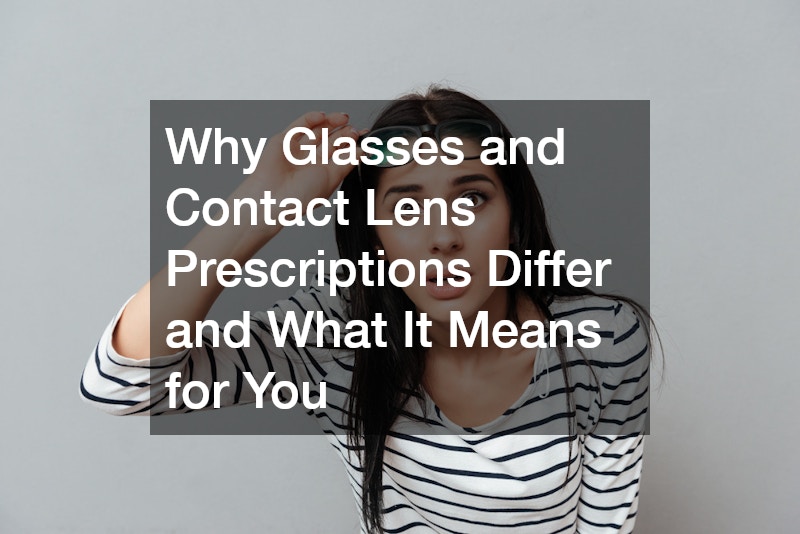Many people who wear corrective lenses might notice a discrepancy between their glasses and contact lens prescriptions. This difference often raises questions, as the idea that your vision can be corrected differently based on whether you’re wearing glasses or contacts can seem puzzling. However, this variation is not only normal but necessary due to the way each type of lens interacts with the eyes.
At the core of these differences is the fact that glasses and contact lenses sit at different distances from your eyes, which requires adjustments in their respective prescriptions. In this article, we’ll explore why this happens and what it means for your vision, providing insight into how opticians adjust these prescriptions to suit your individual needs.
The Role of Distance in Prescription Strength
The primary reason glasses and contact lens prescriptions differ is that they are positioned differently relative to your eyes. Glasses are positioned about 12 millimeters from your eyes, whereas contact lenses are placed directly on the surface of your corneas.
This difference in distance affects how light is refracted, and consequently, how the prescription is formulated.
To illustrate this, imagine holding a magnifying glass and noticing how the image changes as you move the lens closer or farther away from the object you are viewing. The same principle applies to glasses and contact lenses. The further the corrective lens is from the eye, the more its strength needs to be adjusted to correct your vision accurately. Opticians use this principle to fine-tune the prescriptions for both glasses and contact lenses.
When Does Prescription Difference Matter?
For individuals with weaker prescriptions, typically those under 4 diopters, the difference between their glasses and contact lens prescriptions is minimal, often negligible. Opticians will often prescribe the same or nearly identical strength for both, as the impact of the distance is not significant enough to require adjustment.
However, for people with stronger prescriptions—typically 4 diopters or higher—the discrepancy becomes more noticeable. As little as 11 millimeters of distance between the eye and the lens can alter the way light is focused, requiring adjustments to ensure clear vision. This is why you might see a more substantial difference in the numbers on your glasses and contact lens prescriptions if you have a higher prescription.
Nearsightedness and Farsightedness: Adjustments in Prescriptions
The effect of distance on prescription strength is particularly relevant for people with either nearsightedness (myopia) or farsightedness (hyperopia). The direction of the adjustment depends on whether you have a minus or plus prescription.
- Nearsightedness (Myopia): If you are nearsighted, your glasses will have a minus (-) prescription. For those with prescriptions stronger than -4.00, the strength of the lens will need to increase as it is moved further away from the eye. This means your contact lens prescription will typically be lower than your glasses prescription. For example, if your glasses prescription is -5.00, your contact lenses might be around -4.75 to compensate for the closer proximity to your eyes.
- Farsightedness (Hyperopia): On the other hand, if you are farsighted and have a plus (+) prescription, the adjustment works in the opposite direction. As the lens moves away from the eye, its strength needs to decrease. Therefore, your contact lens prescription will usually be stronger than your glasses prescription. For example, if your glasses prescription is +5.00, your contact lens prescription might be closer to +5.25.
These differences in prescription strength ensure that your vision is equally well-corrected, whether you’re wearing glasses or contact lenses.
The Effect on Image Magnification
Another aspect to consider when comparing glasses and contact lenses is the impact on image size, also known as image magnification. This is particularly relevant for individuals with nearsightedness. When wearing glasses with a minus prescription, the image you see may appear slightly smaller than it actually is. This happens because, as the lenses are moved farther from the eyes, the light passing through them is bent in a way that shrinks the image.
With contact lenses, however, the effect is less pronounced. Since they sit directly on the eyes, the image size remains closer to its actual dimensions, and objects may appear slightly larger than they do with glasses. While this difference is usually minor and unlikely to affect your daily life, it’s worth noting that the shift in image size is more noticeable with stronger prescriptions.
Will Different Prescriptions Worsen Your Vision?
One common concern among individuals who wear both glasses and contact lenses is whether having two different prescriptions might negatively impact their eyes. Fortunately, there’s no need to worry—these adjustments are made precisely to ensure that both types of lenses provide the correct refractive power based on their positioning.
Opticians design these prescriptions to work in harmony with the way light enters your eyes, ensuring that your vision remains clear and sharp. The difference in prescription strength is simply a compensation for the physical distance between the lens and your eye, and it doesn’t indicate any change in the health of your eyes or the effectiveness of your vision correction.
Conclusion
The differences between glasses and contact lens prescriptions are based on the fundamental principles of light refraction and the positioning of the lenses relative to your eyes. For weaker prescriptions, the difference may be negligible, but for stronger prescriptions, the adjustment is critical to maintaining the same clarity of vision. Opticians take great care in tailoring each prescription to your specific needs, ensuring that both glasses and contact lenses provide optimal correction for your eyesight.
Whether you wear glasses, contact lenses, or both, rest assured that the prescription difference is a natural and necessary part of ensuring your vision is at its best. Your optician will continue to monitor and adjust your prescriptions to ensure your visual experience remains clear and comfortable, no matter which form of correction you choose to wear.
.

